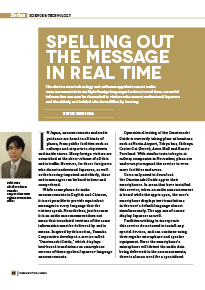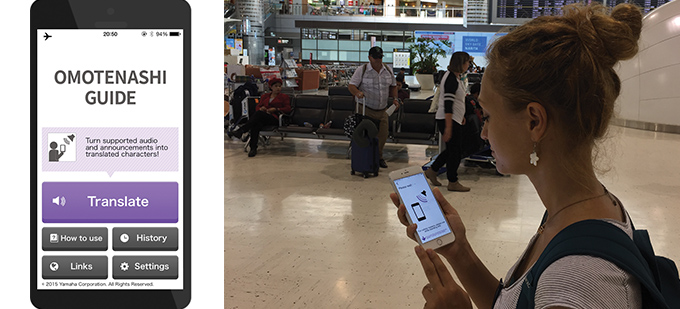Home > Highlighting JAPAN >Highlighting Japan November 2015>Science & Technology
Highlighting JAPAN

Science & Technology
Spelling Out the Message in Real Time
Thanks to a new technology and software app that convert audio announcements into multiple foreign languages in close to real time, essential information can now be channeled to visitors who cannot understand Japanese and the elderly or disabled who have difficulty hearing.

In Japan, announcements and audio guidance are heard in all kinds of places, from public facilities such as railways and airports to city streets and inside stores. Many foreign visitors are astonished at the sheer volume of all this audio traffic. However, for those foreigners who do not understand Japanese, as well as the hearing-impaired and elderly, these audio messages can be hard to hear and comprehend.
While some places do make announcements in English and Chinese, it is not possible to provide equivalent messages in every language that the visitors speak. Nonetheless, just because it is an audio announcement does not mean that translated versions of the same information must be delivered by audio means. Inspired by this notion, Yamaha Corporation developed a service called "Omotenashi Guide," which displays text-based translations on smartphone screens of these spoken Japanese-language announcements.
Operational testing of the Omotenashi Guide is currently taking place at locations such as Narita Airport, Tokyu bus, Shibuya Center Gai (Street), Aeon Mall and Sanrio Puroland. With similar tests to begin at railway companies in November, plans are under way to expand the service to even more facilities and areas.
Users only need to download the Omotenashi Guide app to their smartphones. In areas that have installed this service, when an audio announcement is heard while the app is open, the user’s smartphone displays text translations in the user’s default language almost simultaneously. The app can of course display Japanese as well.
Facilities wishing to incorporate this service do not need to install any special devices, and can continue using their regular microphone and speaker equipment. Since the smartphone’s microphone will detect the audio data being delivered in the announcements, there is also no need for a specialized communication environment, such as an Internet or Wi-Fi connection. In addition to there being no limit to the number of compatible languages, another major advantage of this service is that it can be used anywhere, including underground complexes, trains, airplanes and so on.
Furthermore, this system works not only for regular, automatic announcements, but is also effective for real-time announcements read by live human voices. Human announcements appear not only as text on the screen, but can also be broadcast aloud in foreign languages following along after the Japanese oration.
“In trains or buses, conductors or drivers frequently make live announcements. Some of them can only speak Japanese, on top of which there is the possibility that what is said is not properly recognized because of their dialects,” explains Yamaha Corporation New Values Promotion Office chief producer Yuki Seto. “Even in such cases, Omotenashi Guide is still able to properly display the necessary information. This is made possible with automated translation technology achieved through a joint research venture with the National Institute of Information and Communications Technology.” Seto also notes that allowing such operators to conduct their work in a normal manner without burdening them was an important point of emphasis while developing this service.
As a service targeted at hearing-impaired users, a function has also been developed that prompts the user to look at the smartphone screen by turning on the smartphone’s vibration mode when an announcement is detected. Although there are possibilities of other functional extensions, Seto explains that “we want to keep the features as simple as possible and achieve a usability that is wide-ranging and highly precise.” Moreover, capitalizing on its strong point—that it is compatible with any language—Yamaha is setting its sights on combining this service with other technologies and services from Japan and marketing it globally.
Foreign tourism to Japan will no doubt continue to rise as the 2020 Tokyo Olympics and Paralympics approach. This looks to become a service that will provide Japan’s unique sense of refined hospitality, or omotenashi, to the people of diverse nations and languages.
© 2009 Cabinet Office, Government of Japan






